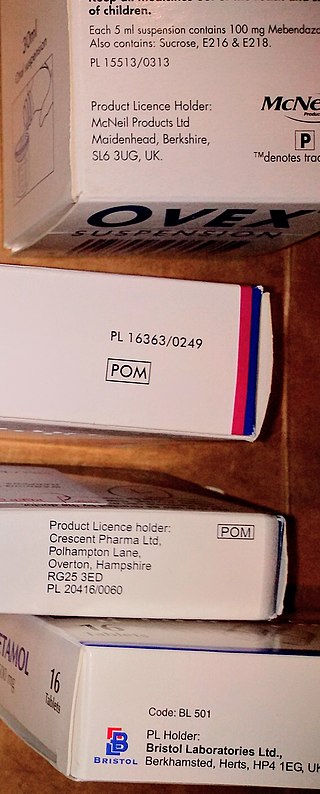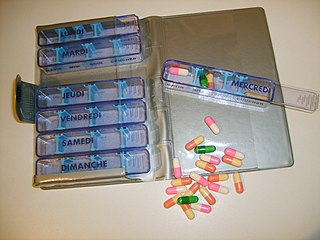
Emergency contraception (EC) is a birth control measure, used after sexual intercourse to prevent pregnancy.

Laudanum is a tincture of opium containing approximately 10% powdered opium by weight. Laudanum is prepared by dissolving extracts from the opium poppy in alcohol (ethanol).

Paregoric, or camphorated tincture of opium, also known as tinctura opii camphorata, is a traditional patent medicine known for its antidiarrheal, antitussive, and analgesic properties.

A medication is a drug used to diagnose, cure, treat, or prevent disease. Drug therapy (pharmacotherapy) is an important part of the medical field and relies on the science of pharmacology for continual advancement and on pharmacy for appropriate management.

A prescription drug is a pharmaceutical drug that is permitted to be dispensed only to those with a medical prescription. In contrast, over-the-counter drugs can be obtained without a prescription. The reason for this difference in substance control is the potential scope of misuse, from drug abuse to practicing medicine without a license and without sufficient education. Different jurisdictions have different definitions of what constitutes a prescription drug.

CVS Pharmacy, Inc. is an American retail corporation. A subsidiary of CVS Health, it is headquartered in Woonsocket, Rhode Island. Originally named the Consumer Value Stores, it was founded in Lowell, Massachusetts in 1963.
A polypill or single pill combination (SPC) is a type of drug combination consisting of a single drug product in pill form and thus combines multiple medications. The prefix "poly" means "multiple", referring to the multiplicity of distinct drugs in a given "pill". In precise usage, a pill is a polypill if it contains at least 4 drugs. An occasional synonym is combopill. A polypill is commonly targets treatment or prevention of chronic conditions.

Hook's Drug Stores was an Indianapolis, Indiana-based drug store chain which was founded in 1900 by John A. Hook. The chain flourished throughout central Indiana for most of the 20th-century.
Express Scripts Holding Company is a pharmacy benefit management (PBM) organization. In 2017 it was the 22nd-largest company in the United States by total revenue as well as the largest pharmacy benefit management (PBM) organization in the United States. Express Scripts had 2016 revenues of $100.752 billion. Since December 20, 2018, the company has been a direct subsidiary of Bloomfield, Connecticut-based Cigna.

An auxiliary label is a label added on to a dispensed medication package by a pharmacist in addition to the usual prescription label. These labels are intended to provide supplementary information regarding the safe administration, use, and storage of the medication. Auxiliary labels provide information which can augment but not replace verbal counselling from a pharmacist.
In the United States, a pharmacy benefit manager (PBM) is a third-party administrator of prescription drug programs for commercial health plans, self-insured employer plans, Medicare Part D plans, the Federal Employees Health Benefits Program, and state government employee plans. According to the American Pharmacists Association, "PBMs are primarily responsible for developing and maintaining the formulary, contracting with pharmacies, negotiating discounts and rebates with drug manufacturers, and processing and paying prescription drug claims." PBMs operate inside of integrated healthcare systems, as part of retail pharmacies, and as part of insurance companies.
A combination drug or a fixed-dose combination (FDC) is a medicine that includes two or more active ingredients combined in a single dosage form. Terms like "combination drug" or "combination drug product" can be common shorthand for an FDC product, although the latter is more precise if in fact referring to a mass-produced product having a predetermined combination of drugs and respective dosages. And it should also be distinguished from the term "combination product" in medical contexts, which without further specification can refer to products that combine different types of medical products—such as device/drug combinations as opposed to drug/drug combinations. When a combination drug product is a "pill", then it may also be a kind of "polypill" or combopill.
CVS Health Corporation is an American healthcare company that owns CVS Pharmacy, a retail pharmacy chain; CVS Caremark, a pharmacy benefits manager; and Aetna, a health insurance provider, among many other brands. The company is the world's second largest healthcare company, behind UnitedHealth Group. In 2023, the company was ranked 64th in the Forbes Global 2000.

A pill organiser, pill container, dosette box, pillcase or pillbox is a multicompartment compliance aid for storing scheduled doses of medications. Pill organisers usually have square-shaped compartments for each day of the week, although other more compact and discreet versions have come to market, including cylindrical and pen-shaped cases. Some organisers have sections corresponding to times of the day. Pill organisers are viewed as a way to prevent or reduce medication errors on the part of the patient, though evidence of effectiveness is not strong and they have been linked to medication errors.
Pharmacy automation involves the mechanical processes of handling and distributing medications. Any pharmacy task may be involved, including counting small objects ; measuring and mixing powders and liquids for compounding; tracking and updating customer information in databases ; and inventory management. This article focuses on the changes that have taken place in the local, or community pharmacy since the 1960s.

Drug packaging is process of packing pharmaceutical preparations for distribution, and the physical packaging in which they are stored. It involves all of the operations from production through drug distribution channels to the end consumer.
Linda Cahn is the founder and president of a nationwide consulting firm, Pharmacy Benefit Consultants. The firm assists corporations, unions, government entities and insurance companies in improving their prescription coverage benefits and decreasing their prescription coverage costs.

The Poison Prevention Packaging Act of 1970 (PPPA); was signed into law by U.S. President Richard Nixon on December 30, 1970. It was enacted by the 91st United States Congress. This law required the use of child-resistant packaging for prescription drugs, over-the-counter (OTC) drugs, household chemicals, and other hazardous materials that could be considered dangerous for children.
Deborah Adler is an American designer.
ScripTalk is an audible medication label technology designed to give access to individuals who are blind, visually impaired, or print impaired. It consists of a device and a microchip attached to the bottom of a prescription drug bottle. The label information is encoded on a Radio-frequency identification (RFID) electronic label (microchip) using the ScriptAbility software by a pharmacist and placed on the prescription package. ScripTalk prescription labels were introduced in the early 2000s. As of 2020, the technology was applied through the United States and Canada.











